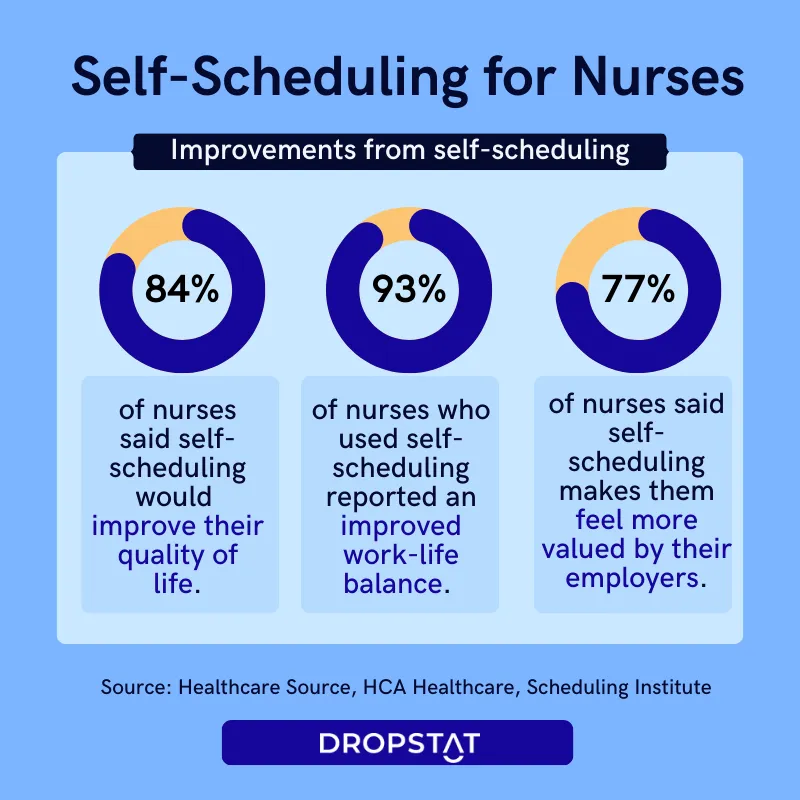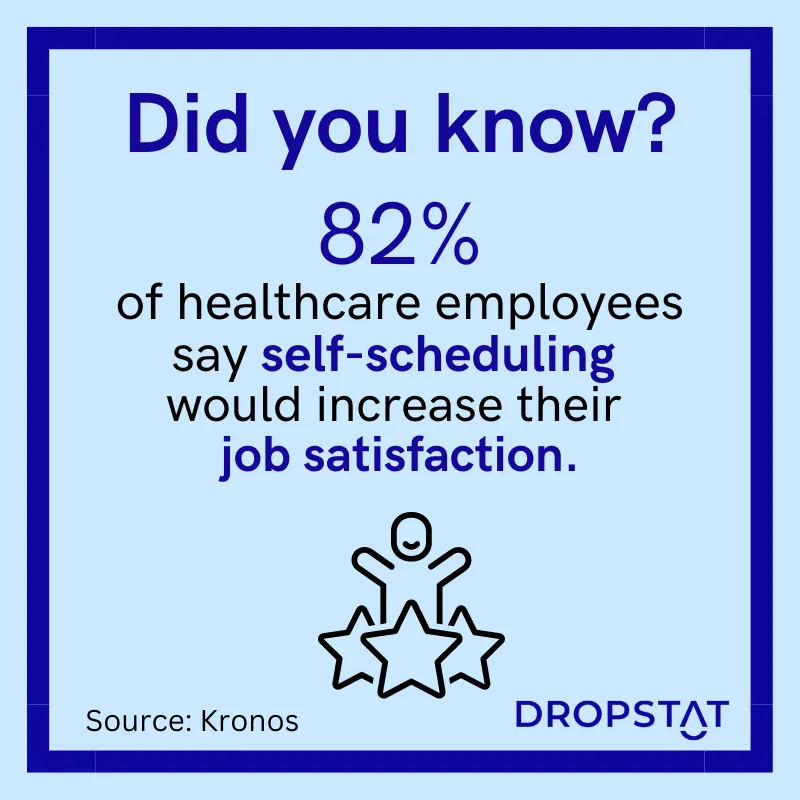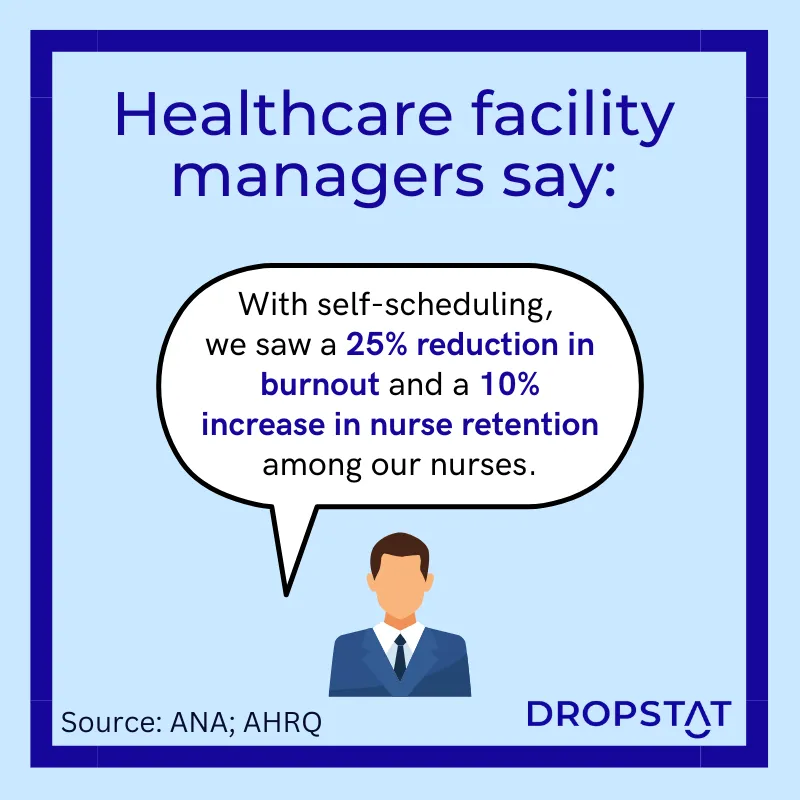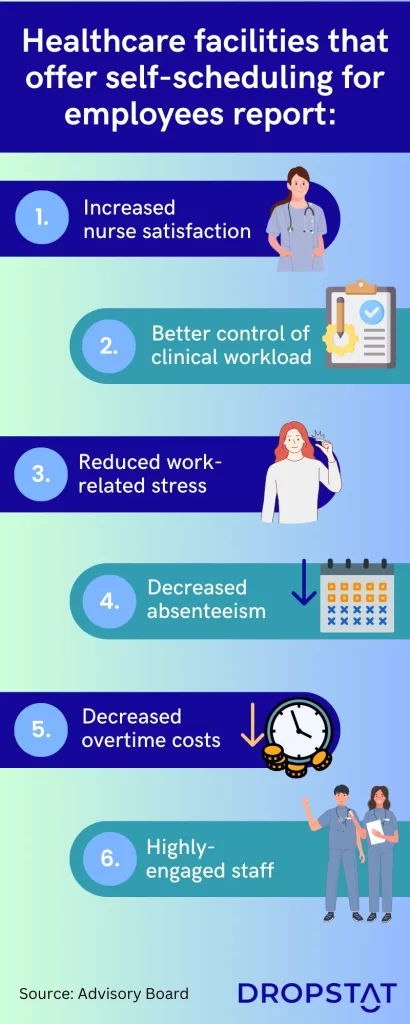Self-scheduling for nurses has gained popularity in recent years. Self-scheduling allows nurses to choose their own work schedules based on their availability and preferences. In a survey of 1,000 employees, 76% said the incentive they would want most was a flexible schedule.
What is self-scheduling for nurses?
Self-scheduling is a system in which nurses have the ability to choose and schedule their own work shifts according to their preferences and availability. Instead of being assigned a fixed schedule by management, nurses are given the flexibility to select their preferred shifts from a list of available options, typically provided through scheduling software. Schedulers always review the schedule and know how many nurses will work for each shift.
The benefits of self-scheduling in nursing
Self-scheduling in the healthcare industry has several benefits for nurses and healthcare facilities. Here are some of the key benefits:
Increased job satisfaction
Self-scheduling gives nurses more control over their schedules, which can increase job satisfaction. Nurses are more likely to feel valued and respected when they are given the freedom to choose their own work hours.
Better work-life balance
Self-scheduling allows nurses to manage their personal and professional responsibilities more satisfactorily, resulting in a better work-life balance. This can lead to reduced stress levels and improved overall well-being.
Improved patient outcomes
When nurses are satisfied with their work schedule and feel less stressed, they can provide better patient care. This can improve patient outcomes, including faster recovery times and reduced hospital stays.
Reduced staffing shortages
Self-scheduling can help reduce staffing shortages by ensuring that there are always enough nurses available to cover shifts. When nurses are given the flexibility to take open shifts and choose their own schedules, they are more likely to work the shifts they prefer, reducing absenteeism and boosting employee morale.
More efficient scheduling processes
The use of specialized software or scheduling tools can make the self-scheduling process more efficient. This can save time for both nurses and management, resulting in more efficient staffing and labor cost management.
Increased flexibility
Self-scheduling provides increased flexibility for both nurses and management. Nurses can pick the shifts that they can work best in and that are most convenient for them, and management can more rapidly adapt to changing demand and staffing needs.
Even though self-scheduling for nurses has pros and cons, many see self-scheduling for nurses as a win-win situation for nurses and healthcare facility managers.

The challenges of self-scheduling for nurses in healthcare facilities
Managers also face challenges when implementing self-scheduling for nurses. These challenges can include:
Managing staffing levels
Self-scheduling can make managing staffing challenging, as nurses may have different preferences for shifts and time off. While providing nurses with the flexibility they desire, healthcare facilities must ensure they always have enough staff to meet patient needs, but not too many, which would result in financial inefficiency.
Ensuring fairness
Healthcare facilities need to ensure that the self-scheduling process is fair and equitable. This can be challenging if some nurses perceive that other nurses have an advantage over them. Healthcare facilities need to be as transparent as possible about the staff scheduling process and ensure that all nurses have equal access to schedule different types of shifts.
Ensuring compliance
Healthcare facilities need to ensure that the self-scheduling of employees is compliant with labor laws and collective bargaining agreements. This can be challenging if nurses have different contractual arrangements or if there are complex scheduling rules that need to be followed.
Technology and training
Healthcare facilities need to invest in technology and provide training to ensure that their staff can effectively use the self-scheduling software. This can be a challenge if nurses are not tech-savvy or if they have different levels of proficiency with technology in nursing.
Balancing workload
Healthcare facilities must balance the workload fairly among all nurses and ensure that nurses with the necessary skill sets are present for every shift. Part of staff management in self-scheduling is making sure that patient care is not compromised as a result of workload distribution.
Ensuring communication
Healthcare facilities need to ensure that there is effective communication between nurses, management, and scheduling staff. This can be a challenge if there are disagreements about scheduling decisions or if nurses cannot negotiate effectively with nurse managers or their colleagues.
Self-scheduling can be a valuable tool for nurses and healthcare facilities, but it requires careful planning and management to ensure that it is successful.

How does self-scheduling work for nursing staff?
Self-scheduling for nurses involves allowing nurses to choose their own shifts guided by several elements, including:
- The shift scheduler defines present and future shifts for the foreseeable future. An app such as Dropstat allows shift scheduling for up to 2 months in advance.
- The scheduler alerts nurses when shifts are created.
- Nurses can respond and select the shifts they want.
- Often, in self-scheduling, nurse managers permit shift trading among nurses as long as HPPD requirements are met. New technology, such as Dropstat scheduling, allows compliance tracking that highlights HPPD compliance in planned shifts.
- Any special limitations or special legal or practical requirements are set forth.
- After shifts are filled, any remaining empty slots in shifts are offered to the other employed qualified nurses, float pools, or travel staff.
- Nurses’ availability and shift preferences count.
- Shifts align with nurses’ energy levels and other life commitments.
- Nurses do not overwork by taking on more shifts than they can physically handle.
- Overtime is an option for nurses who choose it.
- Overtime can be a bonus offered to qualified nurses.
Some facilities allow nurses to self-schedule all shifts, and other facilities allow nurses to choose a certain number of shifts that they can schedule themselves. Overall, autonomy in scheduling can be made to work to the advantage of all parties.
How self-scheduling enhances the employee scheduling experience
Using self-scheduling software for nurses simplifies the scheduling process for management. However, nurses enjoy several other benefits that build up work fulfillment and influence retention. Some of these are
- transparency and predictability of working hours
- knowing that nurses will work in a fully staffed shift
- setting their own schedules with less of a struggle
- enjoying flexibility with work hours
- choice of picking up open shifts or working overtime

10 best practices for implementing self-scheduling in nursing
Implementing guidelines for successful self-scheduling in nursing units can be complex, but adopting some best practices can ensure successful implementation.
- Establish clear guidelines: Healthcare facilities should establish and share clear guidelines for self-scheduling, including any eligibility criteria, scheduling rules, and procedures for requesting time off. This can help ensure that the scheduling process is fair and transparent.
- Involve nurses in the process: Nurses should be involved in the development and implementation of scheduling resources. Healthcare facilities can periodically gather feedback from nurses through surveys or focus groups to ensure that the scheduling process meets their needs.
- Provide training and support: Healthcare facilities should provide training and support to nurses on how to use self-scheduling software and navigate the scheduling process. This can help ensure that nurses are comfortable with the system and can use it effectively.
- Establish communication channels: Healthcare facilities should establish communication channels between nurses, management, and scheduling staff to ensure that there is effective communication and collaboration among nurses throughout the scheduling process.
- Use data analytics to inform scheduling decisions: Healthcare facilities should use data to inform scheduling decisions, including patient acuity figures, staffing levels, and trends in nurse preferences. This can help ensure that patient needs are met and that nurses are able to schedule shifts that meet their needs.
- Regularly evaluate and adjust the process: Healthcare facilities should regularly evaluate the self-scheduling process, checking, for example, if nurses are doing their required hours and making adjustments as needed. This can help ensure that the process remains effective and meets the needs of nurses and patients.
- Foster a culture of accountability and ownership: Encourage nurses to take ownership of their schedules and promote a sense of accountability among the staff. This can help ensure that shifts are covered and the scheduling process runs smoothly.
- Staff reconciliation procedures: Establish a fair and transparent system for resolving scheduling conflicts or discrepancies.
- Diversity, equity, and inclusion: Ensure all nurses have equal access to scheduling opportunities. This can be facilitated with customized software.
- Healthcare compliance: Healthcare managers can communicate with their healthcare compliance consultant to evaluate and improve compliance with regulations.

Job trends with flexible scheduling for nurses
Nurses are increasingly seeking convenient ways to pursue their desired careers in nursing. Self-scheduling is common in some nursing careers. Here are a few examples:
- Per-diem nurses work on an as-needed basis and can choose the shifts they work based on their availability.
- Travel nurses who work on temporary assignments in different locations can choose their own schedules and work in different departments.
- Part-time nurses work fewer hours than full-time nurses and can better manage their personal and professional responsibilities.
- Nurse practitioners, with their advanced knowledge and autonomy, have more control over their schedules than other nursing roles, which allows them to work a more flexible week.
By offering nursing jobs with flexible schedules, healthcare facilities attract and retain top nursing talent while improving nurse job satisfaction.
How Dropstat empowers nurses with self-scheduling
Dropstat, an AI-driven staff scheduling app designed for the healthcare industry, combines the best staff scheduling software technology with understanding the scheduling needs of nurses. This enables schedulers to build effective schedules and staff each shift with energetic and willing nurses.
Nurses are introduced to Dropstat with 2 months of gradual training. With hyper-care from Dropstat staff, the facility’s nursing staff acclimatizes to Dropstat’s cutting-edge staff scheduling software. With this, self-scheduled nurses and the facility reap the great benefits of self-scheduling, improving staff satisfaction and retention.
Schedule a demo to discover ways in which your facility could successfully retain and attract top talent to make your facility a safer place to receive care in.







